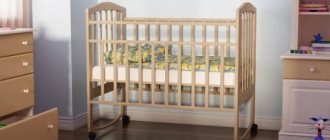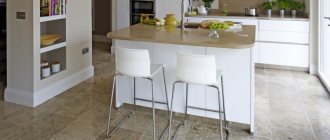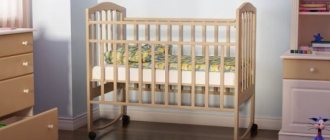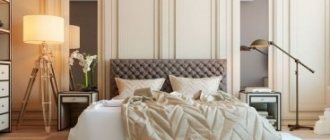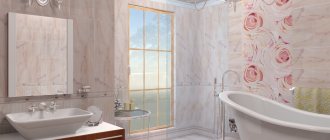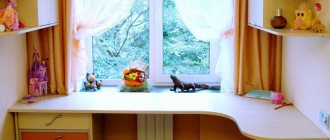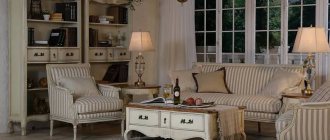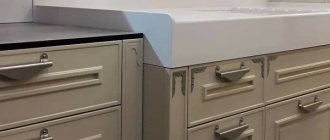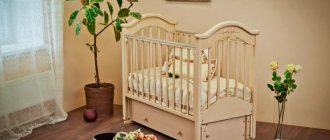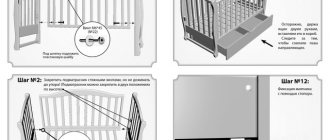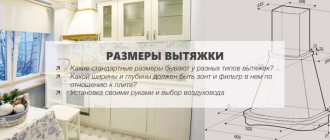Parents approach arranging a sleeping place for a child very responsibly, but in the process of choosing a bed they often reach a dead end. The most difficult question is deciding on the size of the bed. In this case, the following points are important:
- The size of the bed and the size of the sleeping place are different concepts;
- The bed must be suitable for the child according to his physical characteristics;
- The bed should not “eat up” all the usable space in the children’s room;
- The current age of the child and the period for which the bed will be used are important.
Now let's look at these nuances in more detail.
What are the sizes of children's beds?
Children's furniture cannot increase in size as children grow older.
For different ages, there are standards that should be followed when choosing children's furniture. There are models:
- for infants (these can be cribs or small beds that are used up to three years);
- for children over three years old;
- for teenagers.
Each group has its own characteristics that should be taken into account. It depends on how comfortable the baby sleeps.
Why can't I order a mattress without exact measurements?
In our country, the very old GOST 19301.3-94 applies to the geometric parameters of beds. It does not correspond to modern life and defines only 2 children's sizes: 60X120 and 60X140. Other meanings in the understanding of GOST are non-standard. Manufacturers of cribs made a decision: since GOST does not specify a sufficient set of geometric parameters anyway, it makes sense to produce those values that are technologically convenient for them. Therefore, each bed manufacturer has different ones. For this reason, children's mattress factories produce any size to suit the client's crib - without additional payments or extended deadlines.
Standard sizes
Standard sized cribs have a bunk bed. Adult models are suitable for schoolchildren and teenagers, the main thing is that they are made from safe materials. The length of such products is 190 cm, width - 90 cm. If it is assumed that the bed will be used at student age, then you should pay attention to two-meter options.
Models measuring 70 x 160 cm are suitable for children from 5 to 12 years old. When buying such a bed, you should keep in mind that after a few years it will have to be replaced. Some manufacturers offer sliding products whose width increases to 80 cm. This option is ideal for an active child.
Restless children should not buy a bed with a height of more than 40 cm from the floor when sleeping.
The height of the sunbeds varies from 30 to 60 cm. The main rule is that they should be comfortable to sit on. If for some reason you purchased a low model, it is easy to make it taller with a thick mattress.
Tips for choosing a mattress, mattress pad, pillow, textiles
In addition to the bed, bedding, which is chosen according to certain criteria, is also responsible for a child’s healthy and restful sleep.
- Mattress
. In size, they must fully correspond to the dimensions of the sleeping place without deformation or the formation of cracks. The height of the mattress for a children's bed is no less important. If for babies this parameter is 6-8 cm, then with each age stage it can be increased by 2-3 cm. As for materials, orthopedists recommend fillers of moderate and high hardness. - Pillow.
Newborns do not require a pillow. However, as you grow, it is necessary to select options that ensure a healthy body position and comfort during sleep - not too hard and high, made from safe hypoallergenic materials. The pillow needs to be changed every 2-3 years. - Textile.
The best option is bed linen made from fabrics with a high content of natural cotton. At the same time, it is necessary to select it exactly according to the size of the pillow and blanket so that the pillowcase and duvet cover do not bunch up or roll down.
Obviously, the selection of a children's bed and bedding depends on many factors. That is why it is important to select furniture slowly, carefully studying each option for comfort, quality and safety. It’s also not worth saving on such things: good sleep ensures good health and proper development of the child.
SON.ru will help you with your choice
Our specialists are the best experts in matters of comfortable sleep and are always ready to help you. We are in touch and will answer all questions. The consultation is absolutely free.
For newborns
According to generally accepted standards, sleeping places of the following sizes are suitable for children: length 110-120 cm, width 60 cm, side height up to 95 cm. The lower part of the crib is adjustable by age: the upper level is for newborns, the lower level is for a child from 3 years old. Manufacturers offer several options for the little ones. First of all, this is a cradle that can be used for up to 6 months. Floor and hanging options usually have dimensions of 0.4 x 0.8 m. Secondly, this is a box. The dimensions of the multifunctional model for children start from 0.9 x 1.1 m and are convenient not only for sleeping, but also for playing.
Popular bed models for three children, useful additions
There is also a classic bed model. The domestic standard size is 1.2 x 0.6, sometimes options are 1.40 x 0.7 m. Foreign models are slightly different in size: 1.25 x 0.68 m and 1.7 x 0.6 m. Type of children's furniture - bedside. A product with a removable wall is usually not produced larger than 1 x 0.5 m.
Classic models
They are most in demand on the market, as they have a number of advantages:
- Made from natural wood;
- The position of the berth is adjustable in height;
- Domestic manufacturers have a low cost;
- Service life up to 3-4 years;
- The bed size is standard 120x60cm or 140x70cm, which greatly simplifies the selection of bedding sets.
Classic beds are presented in several modifications, which have different principles of “swinging” the child:
— The pendulum is practical and thoughtful. The swinging mechanism allows the mother to quickly put the baby to bed without straining her back during the swing. The design principle is simple, the frame itself is attached to the base using a special mechanism with bearings, so when swinging the base remains motionless. According to the principle of direction, swings are divided into three subtypes:
- Universal - swings in any direction;
- Transverse - “left-right”;
- Longitudinal - “back and forth”.
Regardless of the selected subtype, the presence of locking latches is mandatory to lock the pendulum mechanism.
- About runners. At the bottom of the structure, instead of legs, there are two arches that rock the crib. Some modifications provide a mechanism for fixing these arches by installing supports or wheels;
- On legs or wheels. A classic design without a swinging mechanism, but usually equipped with under-bed drawers, saving money and space when purchasing a chest of drawers or wardrobe on the ground.
It is worth noting the disadvantages of classic beds, including:
- Large bed for newborns. Since the baby is not yet accustomed to a lot of free space around him, he may feel uncomfortable. Many mothers are purchasing a baby cocoon for the first time or covering the area under the hips with rolled up towels or blankets;
- Dimensions and weight. Unfortunately, despite many advantages, such cribs take up a lot of space, so you should consider this point before purchasing.
Cradles
This type is very popular among parents who want to create comfortable conditions for themselves and their kids. This model can be equipped with a bow with toys, a visor, wheels and other elements, but the main feature is a manual or automatic motion sickness system.
Typically, these models are designed for babies up to 8-12 months, so their length does not exceed 85-95 cm and the width is 50 cm. When the baby is 8-12 months old, the crib will need to be changed to another.
The disadvantage of such models is that they do not have the necessary stability. This must be taken into account during operation.
A simple cradle that can independently rock a newborn, supporting a weight of up to 20 kg.
Rocking beds
They appeared because many children get used to falling asleep when rocked. Sometimes it is difficult to hold a growing and growing baby in your arms; a rocking bed is an excellent solution. There are various mechanisms for motion sickness, but the most popular option is beds on runners, in which the entire structure moves with the legs.
Transformers
As the name suggests, these are beds that can be transformed into other furniture or the shape and size of the bed can be changed. This type is gradually beginning to replace classic models due to its high functionality and practicality advantages:
- The cradle can grow with the baby and, unlike classic models, the transformer has undergone a small shelf, convenient for newborns;
- Long service life up to 7-12 years;
- Variety of shapes;
- The modifications include options with all the necessary furniture, which can also be transformed.
The disadvantage can also be seen in the dimensions, because when the transformer “grows” to its maximum size, it will take up no less space than the classic version, but in the “child” size they are not bulky.
Attached models
Overlay frames are an ideal solution for nursing mothers - the baby will always be nearby. The structure is installed or mounted next to the parents’ bed. Its second part is protected by a wooden edge. This product will easily fit in the smallest room, and the baby can sleep in the crib for up to 1 year.
The width of the crib is 40-50 cm and the length is 85-95 cm. A child can only sleep up to 1 year, so you will have to buy new furniture.
Is the baby no longer sleeping in the additional model? Turn it into a comfortable chair, and if you put a chair here, you get a table!
Beds for two
Parents of twins or twins are very often forced to buy two separate beds for each of the children, since such amenities are not available everywhere or not all rooms are comfortable.
When children grow up to 3-4 years old, you can take care of a bunk bed, which will help you save space and fit perfectly into the children's room.
From 0 to 3 years
According to current standards, a little person from birth to three years old is provided with a crib with a sleeping area of 110-120 cm by 60 cm. The sides are made no higher than 85-95 cm. The position of the mattress at the bottom is about 30 cm from the floor level, the top - 50 cm. The lower part of the product is adjustable in terms of installation height: the upper level is suitable for children up to 1.5 years old, the lower level is suitable for children over three years old.
Sometimes they buy cribs with the dimensions of the bed itself being 40 by 80 cm - they are completely stuffed with soft material, there are floor models and models suspended from the ceiling. The upper part of the crib is decorated with a fabric canopy, the lower part with a lambrequin. The cradle acts as a kind of cocoon in which the baby is comfortable, because it is protected from all sides, and is used for a maximum of six months.
A rocking bed is designed for children who fall asleep only if they are rocked - usually this design is a bunk with rails along which the entire object moves from side to side. There are also options for programming the pendulum: using the remote control you set the time and amplitude of the oscillations.
Cradles, rocking chairs for babies from 0 to 3 years
Beds in the form of cribs and rocking chairs are available in various variations.
Their distinctive features are:
- safety;
- comfort of the child's stay;
- compact overall dimensions;
- the same motion sickness of the child upon awakening;
- mobility.
The disadvantage of using the product is the short shelf life of cribs - up to 6 months, rocking chairs - up to 3 years. The cradles are made on the basis of pendulum mechanisms.
Types of products are divided according to the principle of action:
- longitudinal pendulum, simulating swinging on the hands;
- transverse pendulum, when the bed swings from side to side;
- universal, combining longitudinal and transverse mechanism (optional).
Rocking beds are arranged using the same principle, which are installed on guides located on the legs of the product. There are 2 options for the location of the guides: longitudinal and transverse.
A rocking chair differs from a cradle in its larger dimensions. Over time, special clamps can be installed on the runners to block the swinging of the product or wheels.
On wheels
The most common models measuring 120 x 60 cm are designed for children under three years of age. They also have height adjustment thanks to a movable bottom. Thanks to the removable side rail, which can be folded or completely removed, the child can climb into the bed independently. The legs of these models are stable or with runners to rock the child.
Over time, when your baby no longer needs to be held, you can attach grab bars to prevent him from tipping over. Additionally, many of these models have drawers for clothing, bedding, or toys located at the bottom or on the side.
Beds on wheels are convenient because they can be easily moved around the room. This is a great option for those babies who sleep poorly and parents have to get up often. The only difference is that wheels are attached to the legs.
Playpen bed
Children's playpens become popular from 6 months to 2 years, when leaving the baby alone is dangerous.
The advantages of the product are:
- durability and convenience;
- functionality, as the beds can be transformed into a changing table, cradle, desk, bedside table;
- safety;
- lower height adjustable;
- mobility.
Boxes vary in shape: round, square, rectangular, oval.
According to the age limit of the child, the following types of playpens are produced:
- wooden structures of standard sizes for children from 0 to 5 years;
- rectangular wooden transformers intended for children from 0 to 12 years old;
- a box bed, covered with fabric, designed for a period of 0 to 3 years;
- The folding travel playpen can be used from 0 to 1.5 years.
Ergonomic playpen beds
If you like to travel or plan to often leave your child with grandma, a playpen is the best choice. This model has two levels: a hanging cradle for a baby up to 6-7 months and a hard bottom on which a baby can sleep up to 1.5-2 years.
The dimensions of the product are 120x60, the height of the model reaches 80 cm, this is enough to prevent the child from falling out of bed. And if you decide to buy a new crib for your child, you can use the playpen as a play area or a place to store toys. Another advantage of playpens is their compactness and quick assembly. They can be folded or unfolded in less than 3 minutes.
Choosing the size of a bed for a newborn is a complex process, during which you need to take into account the age of the child, the budget for furniture and the size of the room in which it will be installed.
For children from 3 years old
The dimensions of a cot for children from 3 to 6 years old should be approximately 60-80 by 140-150 cm. The optimal height is 30 cm. At 3-4 years old, the protective sides are removed. For a child of this age, you can choose non-standard figured models and transformable beds.
Modular
Beds for children over three years old differ in their assembly. Previously, cabinet furniture was in demand. It was a solid structure, not attached to the wall. If there were different compartments and lockers, they were all fastened together.
Currently, modular furniture is increasingly used for interiors. It can consist of several elements, each of which represents a completely separate block. Such a product, made of high-quality materials, is expensive.
Modular models of cribs usually consist of 1-2 beds, lockers, bedside tables, a play area or an office. If desired, some bricks can be removed or something added.
Transformable bed
This is a complete furniture set, which includes a crib, chest of drawers and linen drawers. As the child grows, the chest of drawers can be used as an independent piece of furniture: a bedside table, coffee table, nightstand.
This crib can be designed for an older child up to 10-12 years old. The length of the bed can vary from 140 to 180 cm, and the width is usually 60 cm.
For children, it is better to buy wooden beds (made of solid wood) rather than beds made of plywood or chipboard. This is especially true for children under 12 years of age, which is associated with their increased activity.
Standard singles
Connoisseurs of classics will definitely like the standard single bed. It has a sleeping place, there are no additional functional elements on it, except for the sides. Such a model will cost less than its competitors, since its manufacture requires much less material. The optimal choice for a child living in his own room.
It’s easy for a parent who has carpentry skills to make it with their own hands. Such a homemade crib for a 3-year-old child will look no worse than a store-bought one.
Thematic
If you want to please your baby with something fabulous, then you should pay attention to thematic patterns. Such a piece of furniture will develop a child’s imagination and give him many magical hours of play. These products are usually a specific item. Recently, a sleeping house for children over 3 years old has become very popular. The roof has a sloping shape and there is often an attic. It is recommended to buy a canopy and soft sides in the kit. The baby will be comfortable there, and during daytime sleep you will be able to shade the sun's rays.
A bed with a side for a child over 3 years old is a machine or special equipment. All products have bright and eye-catching colors. Children's beds for girls from 3 years old can be decorated in the form of a stroller, a water lily, or a fairy-tale house. Manufacturers are able to satisfy the desire of any child.
Roll-out
For older children, choose beds with a pull-out bunk bed. During the day it hides in a niche. Most often, such products have two beds, sometimes even three. Each of them extends beyond the top, forming a staircase. Such original cribs are not very high, it is almost impossible to fall out of them, but they rarely come with bumpers. Convenient for a large family.
It will be easy for a child to roll out such a bed without the help of an adult. The main thing is that the retractable mechanism works flawlessly. To do this, you should definitely try to open an establishment in the store several times.
Children's furniture from Dommino
The configuration of the models is very diverse: simple products with sides, beds with a folding changing table, with a chest of drawers, with linen drawers, with a swing mechanism. You can also find non-standard options: enlarged (bed 140x70 cm), reduced (cradles with parameters 90x45 cm), hybrid (able to transform and grow with the child). You can choose the configuration according to your taste and budget, but experts recommend using optimal parameters for the sleeping place (120x60 cm). It is easier to choose a mattress for them; they are guaranteed to last up to 3 years.
For teenagers
A teenager needs an almost “adult” bed, with a bed size of 70-90 cm by 180-190 cm, up to 50 cm in height. Imported designs are wider - about 100 cm. There are also sliding options that change as they grow older - from 120 to 180 cm. The model is convenient because it does not require replacement after a couple of years - the crib is made as durable as possible, from high-quality materials.
A mattress for a “growing” bed does not always need to be completely replaced - individual options are created using one or two fragments of the same texture as the main product.
Bed sizes for preschoolers and schoolchildren
A crib for a child 4-7 years old has the following dimensions: sleeping area 60 by 140 cm, height from the ground - about 30 cm. After three to four years, the railings disappear. The student bed is a little larger: 80 by 160 cm, height from the floor level 40 cm. There are other parameters: 75 by 150 cm. Many of these products are painted in bright colors, stylized as boats, cars, decorated with lace trim, a canopy of delicate colors, equipped with a drawer that can serve not only as storage, but also as an additional surface for board games.
Children of any age love to jump on the bed, so that the furniture does not break too quickly, it is recommended to buy a structure with the most durable base.
Loft bed
The sleeping place for this model is located above the floor at a height of 1 to 1.5 meters, and below it is an area for games, sports or a table for studying. This crib is equipped with sides on the sides to prevent the child from falling while sleeping. It is worth noting that such a bed is very large, but will allow the child to organize his own personal corner in the room.
The loft bed is a compact two-story structure with a sleeping area on the second floor.
Transformers
Transformable beds are very convenient to use in small apartments. Some models can turn into a table or other piece of furniture. There are baby cribs with sides that can be used from birth to school age. As the baby grows, parents remove the high sides and buy a larger mattress. High-quality furniture of this type can be used for up to 10 years.
Single
It is better for school-age children to purchase bed models. They can be no smaller in size than adult beds, but differ in the requirements for the quality of materials used and design.
The standard size of a single bed is 100 cm wide and 190 cm long.
Bunk
This model is ideal for a small room where two children aged 7 years and older live. Takes up less space than single structures. Most two-tier products have a size of 90 x 190 cm - this is the standard. Due to decorative and additional functional elements, the length sometimes increases to 210 cm. The height usually does not exceed 180 cm. This parameter should be selected based on the height of the ceilings in the room.
Selected varieties
Most modern children's beds have an original, ergonomic and safe design and have a themed, usually soothing, color scheme.
The smallest rocking chairs have a bed size of 80.0 x 43.0 centimeters, which allows it to be placed not only in a separate room, but also next to the parents’ bed. Many of them have height-adjustable support bars, which significantly increases ease of access to the child. The advantage of such models should be considered the ability to combine rocking a child with reading a book, watching news on the computer and just half-asleep.
Most modern cradles are sold together with a base, allowing the bed to be used in suspended and floor-mounted versions. In addition, some manufacturers build into the frame a box for children's things or a rack for placing baby care items. The cradle is initially equipped with enclosing sides and has a special drapery inside.
Stationary cribs are presented in a wide range and each type requires a separate description. Conventionally, they can be divided into the following categories:
vote
Article rating
Sizes of different types of children's beds
The crib in which a newborn sleeps is standard size 97 * 55cm, the height varies depending on the model and is adjustable. Cribs are neatly designed and small in size, but after six months, a standard child grows out of a similar crib and needs a new one. A crib is suitable for a small apartment and for those parents who are willing to spend money on children's furniture and replace it in a timely manner. It is convenient to use a lullaby in the parents' room in the first six months of a baby's life, when you want to maintain the connection between mother and child for as long as possible.
The attached model will become an extension of the parent's bed, on which the baby will sit comfortably. The size of the side bed is standard 90 * 50cm, which is slightly smaller than the classic model
It is important that the attached model has the ability to adjust the bottom to “match” the height of the parent’s bed, but it is better to choose in advance the model that is ideal for an adult. Another important point is the presence of elements for attaching a crib to an adult, which will ensure the safety of the child while sleeping
A classic bed for newborns has standard Russian dimensions of 120 * 90 cm, in Europe these dimensions are 5 cm larger - 125 * 95 cm. The classic among beds is distinguished by the presence of a swinging mechanism - a pendulum (it can be longitudinal and transverse) or its absence, therefore the bed has removable legs and wheels or runners.
The classic model, as a rule, has two lower positions, a slatted bottom, and the ability to lower the front side; some models have an additional drawer at the bottom.
Transforming the crib will be a good investment in the child’s future - it will be useful for a newborn and will last up to 7-8 years (until the child outgrows the product). The transforming bed has a built-in chest of drawers and a changing table, standard size 140 * 70cm, sleeping place for a child 90 * 60cm with the possibility of increasing it. After the initial appearance, the product becomes small for an older child, the chest of drawers with the changing table is removed, and the bed is expanded.
There are models of children's furniture for twins or twins, which are a product with parameters of 130 * 125 cm. A bed for children will last about 3 years, so you will need to replace it with a spacious two-tier model or separate products for each child.
In addition, there are cots of different sizes, which are a playpen at the bottom and a sleeping area at the top. The sleeping area is small and will be used by a child until one year of age, after which the child is unlikely to fit.
Beds of non-standard sizes are unique in their design, for example, round and oval models with dimensions of 78 * 76 * 81 cm (length * width * height), which “grow” in length up to 128 cm for children of non-standard sizes. Standard ones are mostly increased in length, which allows the use of an expensive model for up to 5 years.
It is worth noting that the parameter 120 * 60 cm, used to indicate the size of a classic-shaped crib, indicates the size of the bed; the crib itself can be larger than 6-10 cm due to the presence of additional elements. - side walls, sides. This applies not only to this model, but also to some other types of children's furniture.
Recommended bed sizes for each age
According to the requirements of Russian GOST for children 0-3 years old, the crib must be at least 120x60 cm. The height of the side rails is up to 95 cm. The bed can be lowered by 30 cm or raised by 50 cm to 95 cm. To prevent the child from falling and getting stuck, the distance between side rail posts should be up to 7.5 cm.
At 3-7 years old, a child needs a bed of 140x60 cm, the level of the mattress should be at a distance of 30 cm, for preschool institutions the standard bed is 120 cm.
Crib sizes vary across Europe. In France, the requirements are identical, only the distance between the side vertical fences is 4.5-6.5 cm. The maximum height of the fence for a crib is 20 cm. Dimensions are 60-90 cm. In Italy, Scandinavia, Germany, children's beds are 5-5 cm longer Russians by 10 cm
All domestic standards relate to rectangular beds; designer analogues can be of any shape, but for safety reasons it is better to focus on accepted standards.
The following standard parameters have been developed for beds for school-age children:
- 6-12 years – 160x80x40 cm (this last indicator characterizes the distance from the floor to the bed level);
- 13-18 years old - 190x90x50 cm.
Before reaching adulthood, most children change three beds; the size is selected taking into account the dynamics of growth. Due to skates, pendulums, shifters, transformers and rocking chairs, they can have other sizes. Permissible load:
- up to one year – 10 kg;
- up to 3 years – 25 kg;
- up to 5 years - 50 kg.
What to consider when choosing a children's bed
It is known that a child’s productivity largely depends on the quality of sleep. Without adequate sleep, academic and athletic performance will decline significantly. And the crib, well, is a durable structure that adapts to the individual and is able to maintain the correct position of the spine during sleep.
For both the developing child and the teenager, it is very important that the room has a bed that captivates them, sparks curiosity, pleasure and imagination. There are so many options on the market, from bunk beds to beds with built-in desks, and you need to know what criteria you need to meet in order to purchase your desired piece of furniture.
you need to know what size a crib should be, what material it should be made of, what additional features it should have, or how to determine if it poses a risk of injury to your baby.
Safety
A safe product is one that cannot cause injury when interacting with it. The bed should not have gaps between the sides: a curious child can stick a finger into it, pinching painfully. Any roughness is also unacceptable - splinters are a very unpleasant thing for a baby’s thin skin. All metal fasteners are disguised with wooden and plastic plugs.
The distance between the crib rods is no more than six cm. The sides are removable and fixed. The bed must be sufficiently stable: the narrower and higher the model, the greater the likelihood of it tipping over. Any sharp edges or various traumatic decorations are prohibited.
Used materials
The quality of the materials from which cribs are made is an important factor in the durability, stability, strength and appearance of the crib. The most recommended materials for making a bed frame are wood and iron, materials that not only last a long time, but are also very beautiful.
- A solid wood bed is recommended due to its stability over time and its heavy weight. These beds are beautiful, warm, and can be made in a variety of shapes and sizes. Beech, oak, ash, walnut or pine are some examples of materials used to make cribs.
- A metal bed is not inferior in strength to a wooden one. Beds with a metal frame are very durable, do not creak and have a good weight.
- A bed made of chipboard has a much lower price, which allows it to be used in a shorter time. You can choose a combination of solid wood with chipboard or metal with chipboard to ensure that your bed lasts long enough. Chipboard is easy to work with and is recommended only for decorative purposes, not for resisting elements.
- A plastic bed is not as durable as wood or metal, but it comes in a variety of shapes and colors, is very easy to maintain and clean, and is safe because it is round in shape and provides security.
Child's age
Age is another aspect to consider when choosing a good bed. The age, build and weight of the child are mainly taken into account. The age of the child affects the aesthetic appearance of the bed, technical characteristics and safety features.
- The aesthetic aspect is very important, because in adolescence there will not be an ideal bed in the form of a racing car, a princess stroller or a Minnie Mouse. But if you're choosing a bed for an older child, you might want to look for a solid wood bed with storage for books and gadgets, or a bed with a desk to combine business with pleasure.
- The weight that the bed can support is selected depending on the age and actual weight of the child. Choosing the wrong bed can affect your baby's comfort. In other words, it should be taken into account that a small child is more likely to “jump” in bed and expose him to additional stress compared to his actual weight.
- Safety devices include those side guards that protect a sleeping child from falling out of bed or from being hit during sleep. In the case of a bunk or hanging bed, there should be bumpers, removable side walls or ladders to protect the child and increase his safety.
Preschoolers often identify with fairy tale characters and have strong early interests, and this should be taken into account when choosing a bed. Now there is such bedroom furniture in the form of cars, boats, and for girls - four-poster beds in which real princesses sleep.
Types of cribs
Biały pokój dla dziewczynki
- A transformable bed is a bed that can be used for a child up to 4 years old by simply unfolding it. The child will be able to use it for a long time. The duration of use of such a bed depends entirely on the height and weight of the child.
- You can choose a simple nativity scene of the desired shape and size; the range of models is very wide. The choice of crib should be based on the child's height and weight, as well as the extent and rate at which he will develop in the future.
- A bunk bed is the ideal solution for two children who need to share the same room. A bunk bed is effective because it saves space in the bedroom.
- A hanging crib is another way to save space in a small bedroom: bunk beds with one or two bunks that have several useful areas, such as a school area with shelves and drawers for books and notebooks, or even play areas for children.
- Loft beds are also models equipped with additional elements that will bring a lot of pleasure to children of kindergarten and primary school age. These are models with stairs and structures (children's bed) or with fairy-tale towers and slides (children's beds).
Terms and rules for replacing a bed for a child
Replacing a crib with a large bed is necessary when a small family member is about to feel too cramped in it. After three or four years, the baby reaches a height of 100-108 cm, squats in a standard design with lattice sides, although there is still a chance that he will accidentally fall to the floor in his sleep. At the moment, we are purchasing a product for preschool age: low restrictive bars are still present here, but the baby can get up and out of the crib independently.
Often a little person who has barely reached the age of a baby is forced to give up the cradle to a soon-to-be-born younger brother or sister. You need to accustom your child to a full-fledged “move” to a big bed in advance: choose similar bedding, try putting plush hares, dolls, etc. First, pillows and mattresses are laid out around the new bed. - in case of accidental fall.
Estimated time frame for replacing a child's bed:
- in 6-8 months;
- in 2-3 years;
- in 6-7 years;
- in 12-13 years.
The exact time to change the crib to a new one depends on the height and weight of the little person. If the structure is broken or deformed, it must be replaced immediately.
Crib materials
Many types, but not all are safe. There can be several of them in one design. They must be natural. The child will chew the grill or rim. You need to find out what kind of paint it is (water-based or not).
- Wood is an excellent, harmless and safe option. These cribs are well ventilated. The material has hypoallergenic properties and retains heat. Solid beech, cherry, and unpainted oak are some of the best and most resilient species.
- Metal is also a harmless material. Very strong and durable. There is a drawback: it's cold. Also keep in mind that hitting metal and hitting wood are different things. This crib needs soft sides.
- Chipboard (chipboard). They are economical and durable. The characteristics are similar to wood. However, resins are added during manufacturing, which can negatively affect the baby’s health. Check the availability of a quality certificate for the product.
- Plastic. Its advantage is a lightweight cradle. This is a durable material, but the most dangerous. Toxic substances are added during the production process. This applies to inattentive manufacturers.
Think carefully before purchasing such a model.
Beautiful examples
The Ukrainian model EllipseBed 7 in 1, according to parents, has no disadvantages. Bed made of alder or beech. It has an original design, the walls are decorated with hearts. Available in different colors, from white to dark. The bottom can have three positions, and there is also a rocking mechanism and wheels with stoppers. Transforms from a crib to a children's table. On bunks with a diameter of 72x72 cm you can place the baby in any direction.
Unusual multifunctional model Sweet Baby Delizia Avorio with a pendulum made in Italy
It attracts attention with its laconic design, made of natural wood. Diameter 75x75 cm, when transformed it stretches to 125 cm
There is a pendulum mechanism, 3 lower positions. There are rollers that are loosely attached and do not have a stopper. Simultaneous use of wheels and pendulum is not possible. The cradle is poorly polished.
This multi-functional turquoise bed made from New Zealand pine isn't cheap, but it will last for generations. High-quality wood processing and material resistance to deformation will delight young parents.
Rating of the best manufacturers
On the Internet you can find many ratings of crib manufacturers, most often they include the following:
- national teams: Krasnaya Zvezda, Lel, SKV, Brichiola, Antel, Papaloni;
- foreign: Pali, Wundermoebel, Bambolina, Valle.
A crib, changing table, bedside table, and separately purchased baby care products are much more expensive than a convertible bed that combines all of these items at once. It is worth noting that domestic manufacturers have long learned to make high-quality furniture, so their models very often lead the charts and are the highest in terms of price-quality ratio.
The versatility of a convertible bed will undoubtedly increase the comfort of a child's bedroom, making efficient use of space. Thanks to the wide range of models presented, it is easy to find exactly what suits your child.
The main advantages during operation are the lightness and quietness of moving parts.
